Home » Mexico Travel Info » Mexico Information » Mexican Holidays » Day of the Dead
Day of the Dead - Dia de los Muertos
 The origins of the Day of the Dead celebrations in Mexico can be traced back to the indigenous peoples such as the Aztec, Maya, P'urhepecha, Nahua, and Totonac. Rituals celebrating the deaths of ancestors have been observed by these civilizations perhaps for as long as 3000 years. In the post-Hispanic era, it was common to keep skulls as trophies and display them during the rituals to symbolize death and rebirth. The festival that became the modern Day of the Dead fell in the ninth month of the Aztec calendar, about the beginning of August, and was celebrated for an entire month. The festivities were dedicated to the goddess Mictecacihuatl, known as the "Lady of the Dead", corresponding to the modern Catrina. In most regions of Mexico November 1st honors deceased children and infants whereas deceased adults are honored on November 2nd.
The origins of the Day of the Dead celebrations in Mexico can be traced back to the indigenous peoples such as the Aztec, Maya, P'urhepecha, Nahua, and Totonac. Rituals celebrating the deaths of ancestors have been observed by these civilizations perhaps for as long as 3000 years. In the post-Hispanic era, it was common to keep skulls as trophies and display them during the rituals to symbolize death and rebirth. The festival that became the modern Day of the Dead fell in the ninth month of the Aztec calendar, about the beginning of August, and was celebrated for an entire month. The festivities were dedicated to the goddess Mictecacihuatl, known as the "Lady of the Dead", corresponding to the modern Catrina. In most regions of Mexico November 1st honors deceased children and infants whereas deceased adults are honored on November 2nd.
Religious Beliefs
 Some Mexicans feel that death is a special occasion, but with elements like water, earth, fire and air of celebration because the soul is passing into another life. Plans for the festival are made throughout the year, including gathering the goods to be offered to the dead. During the period of October 31 and November 2, families usually clean and decorate the graves. Most visit the cemeteries where their loved ones are buried and decorate their graves with ofrendas, or offerings, which often include orange marigold called "cempasuchil", originally named cempaxochitl, Nahuatl for "twenty flowers", in modern Mexican this name is often replaced with the term "Flor de Muerto", Spanish for "Flower of the Dead". These flowers are thought to attract souls of the dead to the offerings.
Some Mexicans feel that death is a special occasion, but with elements like water, earth, fire and air of celebration because the soul is passing into another life. Plans for the festival are made throughout the year, including gathering the goods to be offered to the dead. During the period of October 31 and November 2, families usually clean and decorate the graves. Most visit the cemeteries where their loved ones are buried and decorate their graves with ofrendas, or offerings, which often include orange marigold called "cempasuchil", originally named cempaxochitl, Nahuatl for "twenty flowers", in modern Mexican this name is often replaced with the term "Flor de Muerto", Spanish for "Flower of the Dead". These flowers are thought to attract souls of the dead to the offerings.
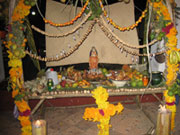 Day of the Dead Offerings
Day of the Dead Offerings
Toys are brought for dead children (los angelitos, or little angels), and bottles of tequila, mezcal, pulque or atole for adults. Families will also offer trinkets or the deceased's favorite candies on the grave. Ofrendas are also put in homes, usually with foods such as candied pumpkin, pan de muerto ("bread of the dead") or sugar skulls and beverages such as atole. The ofrendas are left out in the homes as a welcoming gesture for the deceased. Some people believe the spirits of the dead eat the "spiritual essence" of the ofrenda food, so even though the celebrators eat the food after the festivity, they believe it lacks nutritional value. The pillows 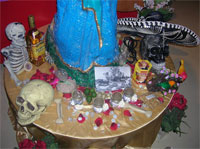 and blankets are left out so that the deceased can rest after their long journey. In some parts of Mexico, such as the towns of Mixquic, Patzcuaro and Janitzio, people spend all night beside the graves of their relatives. Some families build altars or small shrines in their homes. These altars usually have the Christian cross, statues or pictures of the Blessed Virgin Mary, pictures of deceased relatives and other persons, and scores of candles. Traditionally, families spend some time around the altar praying and telling anecdotes about the deceased. In some locations, celebrants wear shells on their clothing so when they dance the dead will wake up because of the noise. Some will dress up as the deceased. Public schools at all levels build altars with offerings, usually omitting the religious symbols. Government offices usually have at least a small altar, as this holiday is seen as important to the Mexican heritage.
and blankets are left out so that the deceased can rest after their long journey. In some parts of Mexico, such as the towns of Mixquic, Patzcuaro and Janitzio, people spend all night beside the graves of their relatives. Some families build altars or small shrines in their homes. These altars usually have the Christian cross, statues or pictures of the Blessed Virgin Mary, pictures of deceased relatives and other persons, and scores of candles. Traditionally, families spend some time around the altar praying and telling anecdotes about the deceased. In some locations, celebrants wear shells on their clothing so when they dance the dead will wake up because of the noise. Some will dress up as the deceased. Public schools at all levels build altars with offerings, usually omitting the religious symbols. Government offices usually have at least a small altar, as this holiday is seen as important to the Mexican heritage.
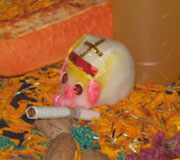 Dia De Los Muertos Skull
Dia De Los Muertos Skull
A common symbol of the holiday is the skull (colloquially called calavera), which celebrants represent in masks, called calacas (colloquial term for "skeleton"), and foods such as sugar skulls, which are inscribed with the name of the recipient on the forehead. Sugar skulls are gifts that can be given to both the living and the dead. Other holiday foods include pan de muerto, a sweet egg bread made in various shapes, from plain rounds to skulls and rabbits often decorated with white frosting to look like twisted bones. The traditions and activities that take place in celebration of the Day of the Dead are not universal and often vary from town to town. For example, in the town of Patzcuaro on the Lago de Patzcuaro in Michoacan the tradition is very different if the deceased is a child rather than an adult. On November 1 of the year after a child's death, the godparents set a table in the parents' home with sweets, fruits, pan de muerto, a cross, a Rosary (used to ask the Virgin Mary to pray for them) and candles. This is meant to celebrate the child's life, in respect and appreciation for the parents. There is also dancing with colorful costumes, often with skull-shaped masks and devil masks in the plaza or garden of the town. At midnight on November 2, the people light candles and ride winged boats called mariposas (Spanish for "butterfly") to Janitzio, an island in the middle of the lake where there is a cemetery, to honor and celebrate the lives of the dead there.
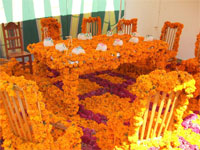 |
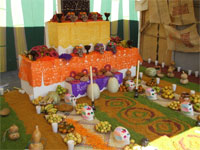 |
| Dia de los Muertos Alter, made from local flowers |
Day of the Dead Alter with skulls |